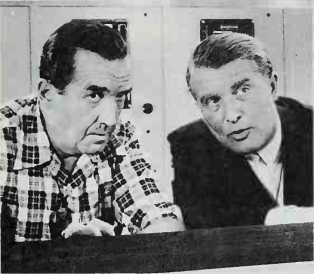Von Manstein’s plan.
Although Brauchitsch nominally commanded the invasion of Russia, 1941, the command decisions lay with okw rather than okh. Brauchitsch saw the taking of Smolensk as opening the way to Moscow; yet failed to oppose Hitler’s decision to secure the Ukraine before pressing the attack. In December 1941, with the German offensive stalled within sight of Moscow because of the delay and Zhukov’s counterattack imminent, Brauchitsch, suffering the aftereffects of a heart attack, recommended withdrawal to defensive positions. Hitler denounced him as a “cowardly wretch” and, forcing his resignation, himself assumed the post of Army c-in-c. Brauchitsch held no further command: arrested by the Allies in 1945, he died while awaiting trial for war crimes. RO’N.

Rocket expert von Braun (right)
Braun, Wernher von (1912-77). Ger/US. Educated at the Berlin Institute of Technology, von Braun took an early interest in astronomy and space flight. In 1932 he joined the German Army Weapons Department participating in the development of rocket technology and subsequently becoming Technical Director of the rocket weapons establishment at Peenemiinde. Throughout the late 1930s he worked on the design of the A-4 rocket that was to be both self-propelled and selfsteering and with a range that would give it strategic potential. Research suffered from Hitler’s decision to make this type of work a low priority. This situation changed in 1943 when he ordered production of the Vergeltungswaffe V-2 rocket, closely based on the A-4. Himmler cast covetous eyes upon the project and in March 1944 briefly had von Braun arrested on trumped-up charges but he was soon released following the intervention of his superiors and Albert Speer. The weapon went into production and over 1,400 V-2s were launched against Britain. In March 1945 von Braun and many of his research team fled from the advancing Soviet army and surrendered to American forces. After extensive debriefing, von Braun was allowed to continue his research in the United States. He was granted American citizenship and played a vital role in the development of American ballistic missiles. Subsequently he became a leading figure in the US space programme. MS.
Braun, Eva (1912-45). Ger. Hitler’s mistress and, briefly, his wife before their joint suicide on April 30 1945.
Breguet 14 (French, WWI). Two-seat reconnaissance or bomber. Prototype flew November 21 1916; first ordered March 6 1917. Large-scale production in two forms: 14.A2 reconnaissance, 14.B2 bomber; deliveries from summer 1917. Very successful and widely used in both versions until and after Armistice. Production until 1926: at least 8,000 built. One 300/310hp Renault 12Fcx/Fcy engine (many alternatives also fitted) max. speed 114mph (182kph); three 7.7mm
' machine guns, 5601b (256kg)
Bombs.
Bren gun. Reliable British light machine gun in service throughout World War II and later.
Brereton, Lt Gen Lewis Hyde (1890-1967). US. Appointed commander, US Far East Air Forces, in October 1941, Brereton had little time to prepare against a Japanese attack: because of poor communications and warning procedures, most of his force was destroyed on the ground at Clark Field, Manila, December 8 1941. In mid-1942 he took command of USA Middle East Air Forces (from November 1942, Ninth Air Force), contributing substantially to the success of the North African campaign — not least by his insistence on Allied inter-service coordination - and inter alia ordering the controversial low-level Ploesti raids. From late 1943, following Ninth Air Force’s re-establishment in the UK, Brereton forged it into a formidable tactical force for the Normandy campaign, its pinpoint attacks on communications routes being particularly effective. On August 2 1944, Brereton became commander. First Allied Airborne Army, responsible for the training, operational planning (including Arnhem), delivery to the combat zone (where they came under ground command), and air supply of all Allied airborne troops. RO’N.
Brest. French naval base in Brittany. After German occupation in 1940, it became a major U-boat base. Scharnhorst and Gneisenau were based there until the Channel Dash of 1942. Heavy bombing by the raf and usaaf reduced much of the town to rubble, but not the submarine “pens”. A German garrison held out until September 1944.
Brest-Litovsk, Treaty of. On December 3 1917 the Bolsheviks and the Central Powers met at Brest-Litovsk to discuss terms for Russia’s leaving the war. In the subsequent treaty, signed on March 3 1918, the Russians ceded the Baltic provinces, Ukraine, Finland, Poland, and the Caucasus. However, Germany’s defeat later that year nullified the agreement.
Brigade (British Army). Functional grouping of battalions and units of all arms. Commanded by a Brigadier. US Army equivalent: Regimental Combat Team.
Briggs, Gen Sir Harold (18941952). Br. Formerly serving in the Indian Army, Briggs came out of retirement to be Director of Operations, Malaya (1950-52). He devised the resettlement plan bearing his name, carried through by Gen Templer. He died from effects of overwork soon after relinquishing his post. See also




 World History
World History









